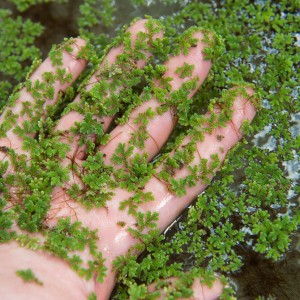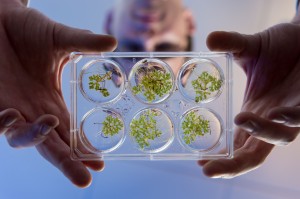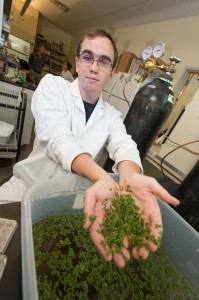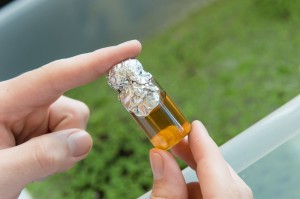Inside Jason Prapas’s backyard sit two blue kiddie pools covered in plastic, each filled with thousands of aquatic ferns the width of a dime growing in a mixture of water and waste. 
Prapas, a researcher at the Energy Institute at Colorado State University, checks the plants, known as azolla, several times a week to monitor their growth and to add water and nutrients. He logs information from his backyard experiment and compares it to data gathered by Ken Reardon, a CSU professor and an Energy Institute colleague, whose students are raising azolla in tubs of water in a lab on campus.
The two are trying to understand the saltiest conditions in which the aquatic fern can grow, how much light and phosphorous it needs to flourish, and whether human or animal waste can provide required nutrients for speedy growth.
With more research, they say, the fern could become a valuable biofertilizer and source of animal feed in developing countries.
“Farmers could raise it to sell, to fertilize their own crops or even feed it to livestock,” Prapas said. “It’s a very versatile plant and could be even more so if we can figure out how to grow it on a commercial scale on marginal resources, such as non-arable land and brackish water.”
Discovering azolla
Prapas became interested in biofertilizers while working in the Arizona desert, researching and growing algae in a greenhouse for a biofuels company.
He noticed that all sorts of plants were growing near a corner of the greenhouse where the algae and water had steadily leaked onto the ground. Prapas watched the growth and became intrigued with the idea of growing algae – or another plant – as a biofertilizer. He researched the concept in his spare time and even approached his company about it.
“They weren’t able to focus on it,” Prapas said. “They were a biofuels company, not a biofertilizer company.”
When Prapas moved to Colorado to get his Ph.D. at the Energy Institute, he began studying the literature on biofertilizers. That’s when he first learned of azolla.
What is azolla?
Azolla is an aquatic fern that floats on the surface of water with long roots
hanging down. The plants grow close together so their leaves overlap and create a
canopy of sorts. (It’s often referred to as mosquito fern because it grows in such a thick mat on the water, it chokes out mosquito larvae.) 
That it grows in both brackish and fresh water is only one of its unique traits.
Azolla grows rapidly – it doubles its biomass every few days. It is high in protein – up to 35 percent by mass. And it is one of the few plants that can fertilize itself – it grows in symbiosis with a photosynthetic bacterium that takes nitrogen from the atmosphere and shares it with the fern.
Many have dubbed it a “super plant” because of its versatility – it provides a natural source of nitrogen, which along with phosphorous, is needed by crops to grow. Its high protein content makes it a good animal feed, and it is easy to harvest by skimming from a pond.
Challenges
Although azolla has long been used as a biofertilizer in rice paddies in China, it has been a traditional, almost coincidental co-crop, not viewed as having commercial potential. That may change as the price of synthetic fertilizer soars along with its energy-intensive manufacturing costs.
One limiting factor is phosphorous. Azolla can provide nitrogen to crops but it lacks enough phosphorous to completely replace chemical fertilizers.
To Prapas, the answer may lie with animal and human waste.
“Animal and human wastes contain phosphorous. In many developing countries, much of the water is polluted with those waste streams,” he said. “With azolla, we could clean this water and produce fertilizer in the same step.”
Prapas and Reardon believe azolla could eventually replace chemical fertilizers in developing countries like Bangladesh, where rising sea levels are overtaking land at a time when the population is growing.
Since azolla is an aquatic fern, it could be grown in those areas where the ocean is encroaching.
“While the potential of azolla as a biofertilizer has been recognized for many years, we need to conduct research to determine which strains are best, how fast they grow and under what conditions – information that is needed to make a business plan in these developing countries,” Reardon said.
Pursuing funding
In the meantime, the two CSU professors continue to grow azolla – Reardon and his students in a lab and Prapas in his backyard setup that cost less than $20 to build. (He is producing enough to fertilize his vegetable garden.)
Prapas now works for Factor(E) Ventures, a nonprofit organization that is headquartered at CSU’s Powerhouse Energy Campus. Factor(E) often partners with CSU researchers, such as Reardon, to innovate solutions to problems in developing countries.
Prapas and Reardon are pursuing funding to continue this research.
In addition to using azolla as a biofertilizer, they think it could be a starting material for the production of biofuels. All while helping to clean waste water.
Not bad for a tiny fern.